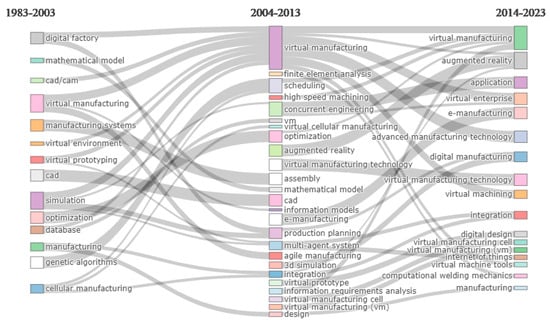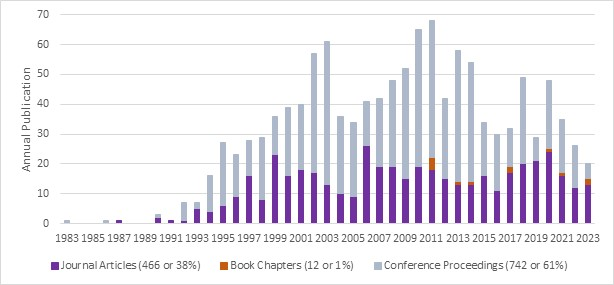Virtual manufacturing (VM) technology emerged in the 1980s as a revolutionary strategy to optimize and streamline the entire product/service manufacturing lifecycle. However, over the years, its popularity appears to have waned. Further, the advent of the fourth industrial revolution (4IR) or Industry 4.0 brings with it other integrated digital technologies, including the Internet of Things (IoT), Blockchain, and digital twin (DT), among others. DT offers functions like VM plus other benefits, including intelligent manufacturing, to revolutionize future manufacturing operations activities and predictive capability using real-time data.
- digital technologies
- virtual manufacturing
- fourth industrial revolution
1. Introduction
Virtual Manufacturing (VM) Technology
Fourth Industrial Revolution and Associated Technologies
2. Thematic Evolution of Virtual Manufacturing Literature (1983–2023)


This entry is adapted from the peer-reviewed paper 10.3390/systems11100524
References
- Savastano, M.; Amendola, C.; Bellini, F.; D’Ascenzo, F. Contextual impacts on industrial processes brought by the digital transformation of manufacturing: A systematic review. Sustainability 2019, 11, 891.
- Radharamanan, R. Virtual manufacturing: An emerging technology. In Proceedings of the 2002 American Society for Engineering Education Annual Conference & Exposition, Montreal, ON, Canada, 16–19 June 2002.
- Iwata, K.; Onosato, M.; Teramoto, K.; Osaki, S. Virtual manufacturing systems as advanced information infrastructure for integrating manufacturing resources and activities. CIRP Ann. 1997, 46, 335–338.
- Graf, M.; Härtel, S.; Binotsch, C.; Awiszus, B. Virtual Manufacturing as Tool for Material and Process Developments and Optimizations. J. Mech. Eng. 2018, 4, 33–59.
- Cheng TC, E.; Choy, P.W.; Wong, S.W. Virtual Manufacturing: Critical Capabilities and Their Organizational Performance Implications. IEEE Eng. Manag. Rev. 2022, 50, 103–114.
- Lim, K.T.; El-Mounayri, H. CAD/CAM-based geometric modeling simulation for virtual manufacturing. In Proceedings of the Electrical Insulation Conference and Electrical Manufacturing and Coil Winding Conference (Cat. No. 99CH37035), Cincinnati, OH, USA, 28 October 1999; pp. 547–551.
- Akpan, I.J.; Shanker, M. The confirmed realities and myths about the benefits and costs of 3D visualization and virtual reality in discrete event modeling and simulation: A descriptive meta-analysis of evidence from research and practice. Comput. Ind. Eng. 2017, 112, 197–211.
- Souza, M.C.F.; Sacco, M.; Porto, A.J.V. Virtual manufacturing as a way for the factory of the future. J. Intell. Manuf. 2006, 17, 725–735.
- Westkämper, E.; von Briel, R. Continuous improvement and participative factory planning by computer systems. CIRP Ann. 2001, 50, 347–352.
- Kumar, K.; Zindani, D.; Davim, J.P. Industry 4.0: Developments towards the Fourth Industrial Revolution; Springer: Cham, Switzerland, 2019.
- Yuan, Q.K.; Luo, S.M.; Tang, W.Y. A collaborative design frame based on virtual prototypes and virtual manufacturing. In Proceedings of the 11th IEEE International Conference on Computer-Aided Design and Computer Graphics, Huangshan City, China, 19–21 August 2009; pp. 568–571.
- Zhou, J.; Liu, Z.Q.; Huang, P.L.; Ai, X.; Deng, J.X. Simulation Diagnosis for the Bottleneck of Production Lines and Its Application. Mater. Sci. Forum 2004, 471, 563–567.
- Akpan, I.J.; Brooks, R.J. Experimental evaluation of user performance on two-dimensional and three-dimensional perspective displays in discrete-event simulation. Decis. Support Syst. 2014, 64, 14–30.
- Li, X.; Wang, L.; Zhu, C.; Liu, Z. Framework for manufacturing-tasks semantic modelling and manufacturing-resource recommendation for digital twin shop-floor. J. Manuf. Syst. 2021, 58, 281–292.
- Gilchrist, A. Introducing Industry 4.0. In Industry 4.0; Apress: Berkeley, CA, USA, 2016.
- Azarian, M.; Yu, H.; Solvang, W.D. Integrating additive manufacturing into a virtual Industry 4.0 factory. In Advanced Manufacturing and Automation; Springer: Singapore, 2021; Volume X10, pp. 587–594.
- Lind, A.; Elango, V.; Hanson, L.; Högberg, D.; Lämkull, D.; Mårtensson, P.; Syberfeldt, A. Virtual-Simulation-Based Multi-Objective Optimization of an Assembly Station in a Battery Production Factory. Systems 2023, 11, 395.
- Onosato, M.; Iwata, K. Development of a virtual manufacturing system by integrating product models and factory models. CIRP Ann. 1993, 42, 475–478.
- Wang, G.G. Definition review of virtual prototyping. J. Comput. Inf. Sci. Eng. 2002, 2, 232–236.
- Mujber, T.S.; Szecsi, T.; Hashmi, M.S. Virtual reality applications in manufacturing process simulation. J. Mater. Process. Technol. 2004, 155, 1834–1838.
- Williams, J.R.; Pentland, A.P. Superquadrics and modal dynamics for discrete elements in interactive design. Eng. Comput. 1992, 9, 115–127.
- Choi, S.; Jung, K.; Noh, S.D. Virtual reality applications in manufacturing industries: Past research, present findings, and future directions. Concurr. Eng. 2015, 23, 40–63.
- Maturana, F.; Shen, W.; Norrie, D.H. MetaMorph: An adaptive agent-based architecture for intelligent manufacturing. Int. J. Prod. Res. 1999, 37, 2159–2173.
- Alexopoulos, K.; Nikolakis, N.; Chryssolouris, G. Digital twin-driven supervised machine learning for the development of artificial intelligence applications in manufacturing. Int. J. Comput. Integr. Manuf. 2020, 33, 429–439.
- Wei, X.; Wu, H.; Yang, Z.; Han, C.; Xu, B. Simulation of manufacturing scenarios’ ambidexterity green technological innovation driven by inter-firm social networks: Based on a multi-objective model. Systems 2023, 11, 39.
- Bühler, M.M.; Jelinek, T.; Nübel, K. Training and preparing tomorrow’s workforce for the fourth industrial revolution. Educ. Sci. 2022, 12, 782.
- Oladele, J.I.; Ndlovu, M.; Ayanwale, M.A. Computer Adaptive-Based Learning and Assessment for Enhancing STEM Education in Africa: A Fourth Industrial Revolution Possibility. In Mathematics Education in Africa: The Fourth Industrial Revolution; Springer International Publishing: Cham, Switzerland, 2022; pp. 131–144.
- Frederico, G.F. From supply chain 4.0 to supply chain 5.0: Findings from a systematic literature review and research directions. Logistics 2021, 5, 49.
- Munirathinam, S. Industry 4.0: Industrial internet of things (IIOT). Adv. Comput. 2020, 117, 129–164.
- Mak, K.L.; Wang, X.X. Production scheduling and cell formation for virtual cellular manufacturing systems. Int. J. Adv. Manuf. Technol. 2002, 20, 144–152.
- Kannan, V.R. A simulation analysis of the impact of family configuration on virtual cellular manufacturing. Prod. Plan. Control 1997, 8, 14–24.
- da Silva, G.C.; Kaminski, P.C. Application of digital factory concepts to optimise and integrate inventories in automotive pre-assembly areas. Int. J. Comput. Integr. Manuf. 2015, 28, 607–615.
- Li, Z.F.; Xu, J. Virtual manufacturing technology and application over tooling machines. Adv. Mater. Res. 2012, 588, 1748–1750.
- Akpan, I.J.; Brooks, R.J. Users’ perceptions of the relative costs and benefits of 2D and 3D visual displays in discrete-event simulation. Simulation 2012, 88, 464–480.
- Qin, S.F.; Harrison, R.; West, A.A.; Wright, D.K. Development of a novel 3D simulation modelling system for distributed manufacturing. Comput. Ind. 2004, 54, 69–81.
- Shen, Z.; Shah, J.J.; Davidson, J.K. A complete variation algorithm for slot and tab features for 3D simulation-based tolerance analysis. In Proceedings of the International Design Engineering Technical Conferences and Computers and Information in Engineering Conference, Long Beach, CA, USA, 24–28 September 2005; Volume 4739, pp. 587–597.
- Karageorgos, A.; Mehandjiev, N.; Weichhart, G.; Hämmerle, A. Agent-based optimisation of logistics and production planning. Eng. Appl. Artif. Intell. 2003, 16, 335–348.
- Tu, Y. Production planning and control in a virtual one-of-a-kind production company. Comput. Ind. 1997, 34, 271–283.
- Novak-Marcincin, J.; Novakova-Marcincinova, L. Application of augmented reality technologies in virtual manufacturing. Acad. J. Manuf. Eng. 2013, 11, 48–51.
- Nyanga, L.; Van der Merwe, A.F.; Matope, S.; Dewa, M.T. A web-based manufacturability agent framework for an E-manufacturing system. Procedia CIRP 2015, 28, 167–172.
- Wen, X.L. Research on the destructive Leadership in Virtual Enterprises. Adv. Mater. Res. 2013, 712, 3199–3202.
- Wang, H. Research on the resource sharing among hierarchically distributed virtual enterprises based on grid system. Open Cybern. Syst. J. 2014, 8, 385–392.
- Yang, J.; Kim, E.; Hur, M.; Cho, S.; Han, M.; Seo, I. Knowledge extraction and visualization of digital design process. Expert Syst. Appl. 2018, 92, 206–215.
- Lambiase, F.; Lambiase, A. An integrated approach to the analysis of automotive assembly activities using digital manufacturing tools. Int. J. Internet Manuf. Serv. 2008, 1, 160–175.
- Kadir, A.A.; Xu, X.; Hämmerle, E. Virtual machine tools and virtual machining—A technological review. Robot. Comput.-Integr. Manuf. 2011, 27, 494–508.
- Akpan, I.J.; Effiom, L.; Akpanobong, A.C. Towards developing a knowledge base for small business survival techniques during COVID-19 and sustainable growth strategies for the post-pandemic era. J. Small Bus. Entrep. 2023, 1–23.
- Anthony Jnr, B. A developed distributed ledger technology architectural layer framework for decentralized governance implementation in virtual enterprise. Inf. Syst. e-Bus. Manag. 2023, 21, 437–470.
 Encyclopedia
Encyclopedia
